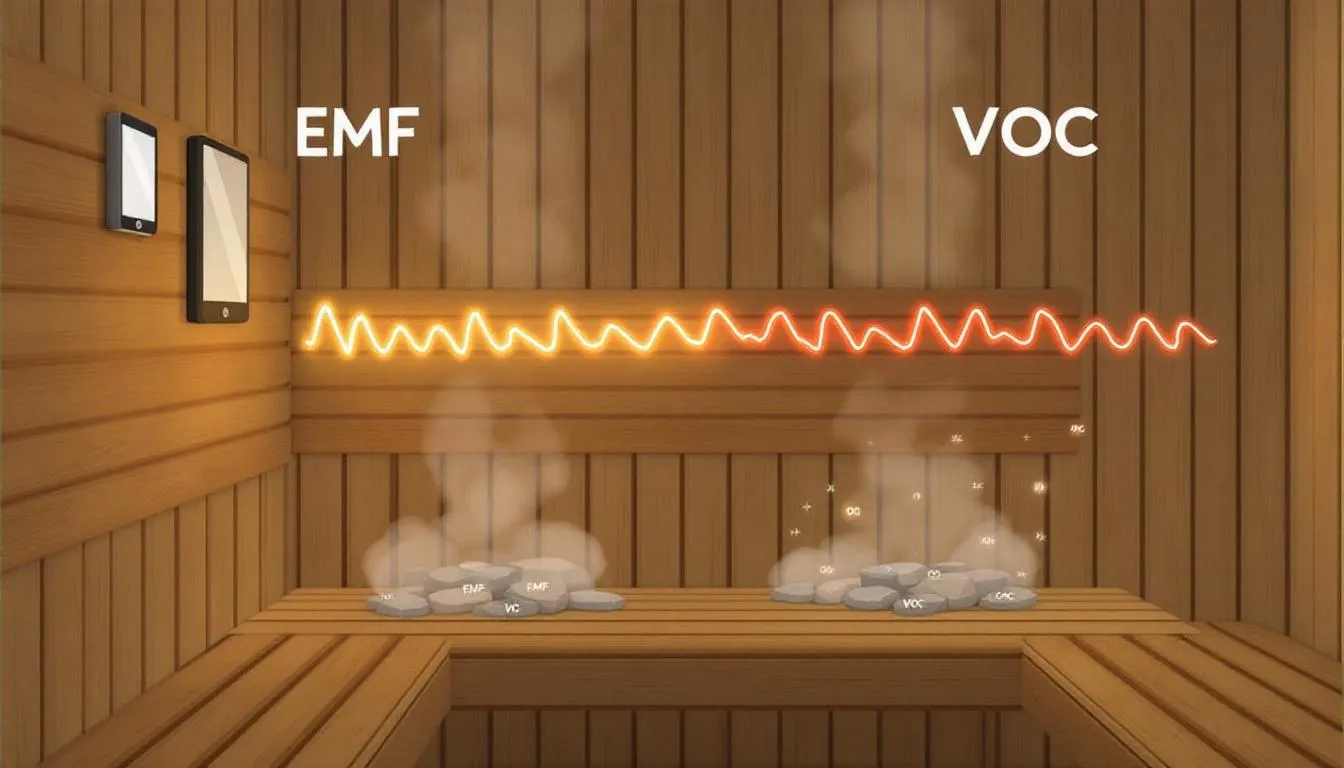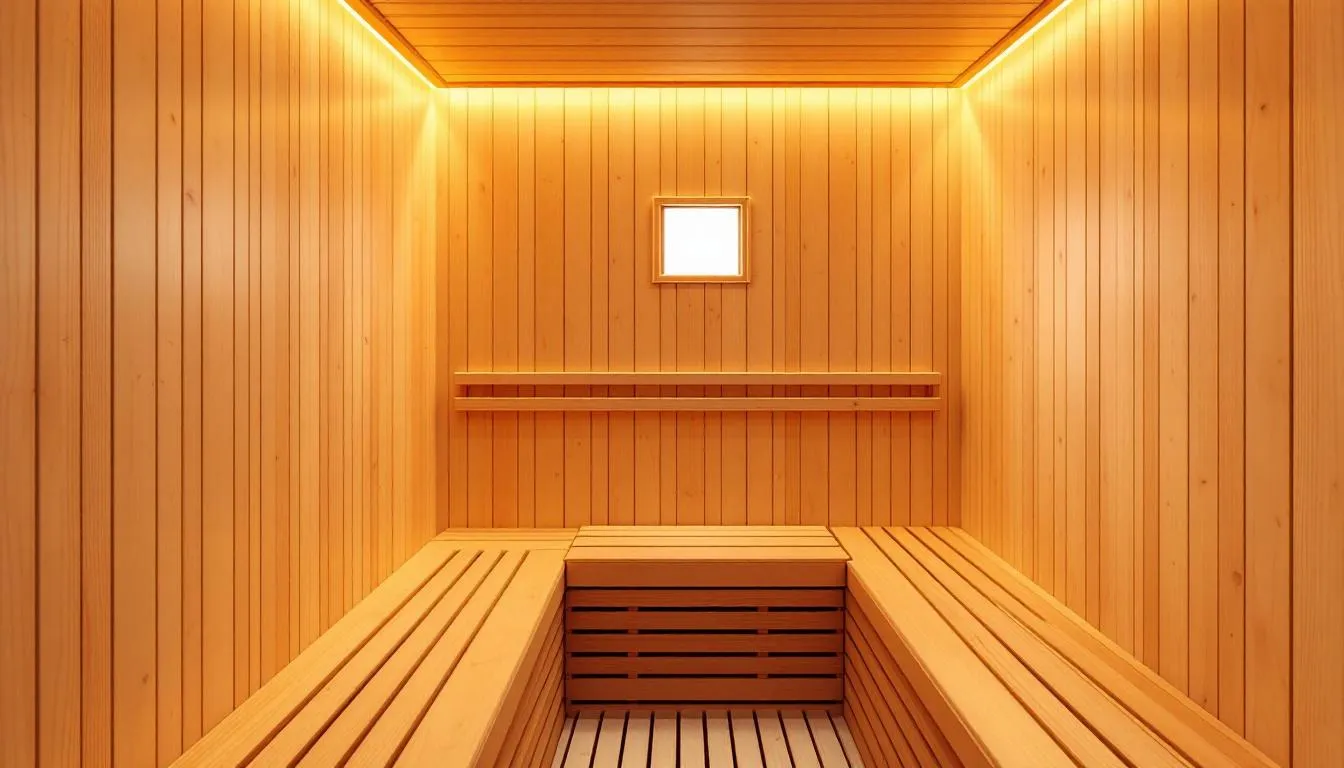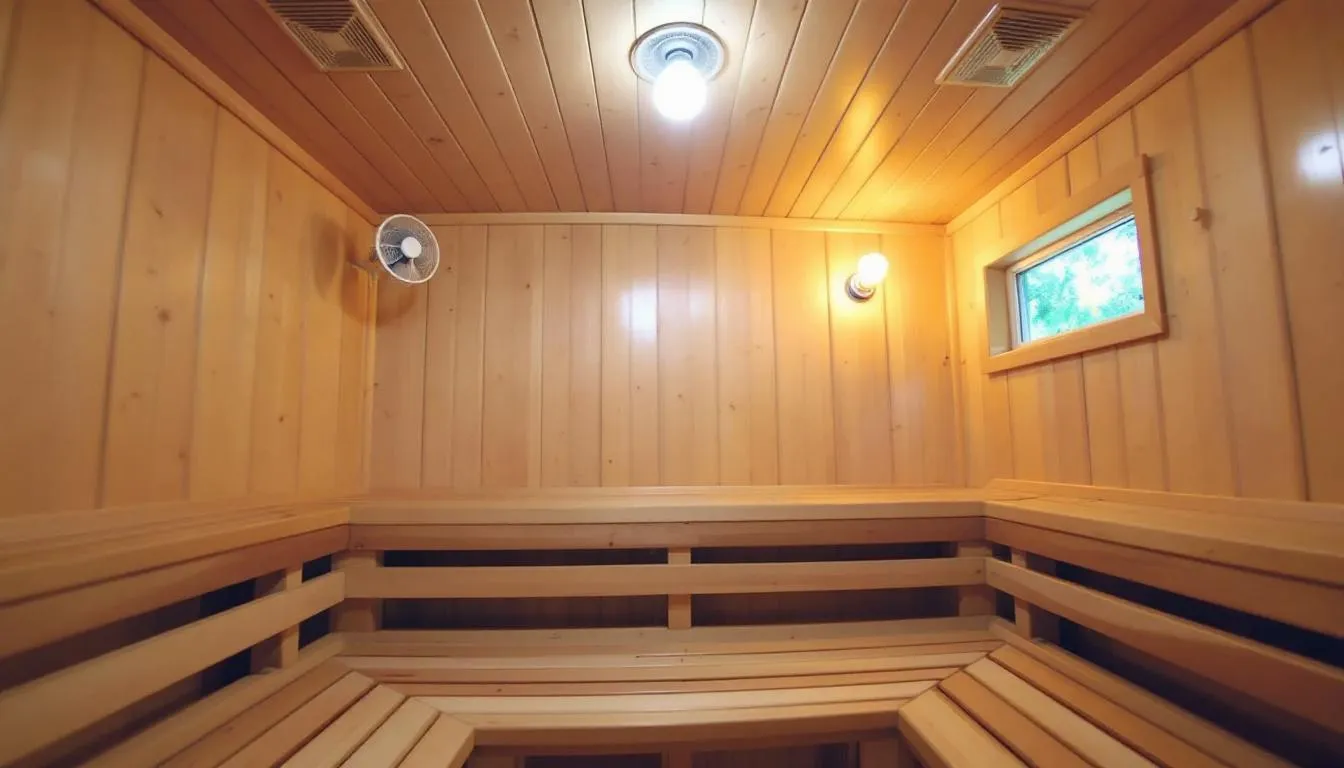Are home saunas safe for health? If you're worried about electromagnetic fields (EMF) and volatile organic compounds (VOC), you're not alone. These are crucial factors that impact your health when using home saunas.
This comprehensive guide will explain what EMF and VOC are, how they affect your safety, and how to minimize risks when choosing the best home sauna.
Key Takeaways
· Understand the importance of EMF and VOC levels in home saunas to ensure a safe and healthy experience.
· Choose low-EMF and low-VOC materials, such as untreated wood, for your sauna to minimize health risks.
· Regular maintenance and monitoring of EMF and VOC levels are essential for maintaining a safe sauna environment.
· Consider the differences between infrared and traditional saunas when making your purchase decision.
Introduction to Infrared Saunas for Home Use
Infrared saunas have become popular for those seeking a relaxing and health-boosting addition to their wellness journey. Unlike traditional saunas, which heat the air around you, infrared saunas use advanced heating elements to warm the body directly.
This gentle, penetrating heat provides a more comfortable and relaxing experience, making it easier to enjoy longer sessions and maximize the infrared sauna health benefits.
Infrared sauna therapy is known for supporting detoxification, muscle relaxation, and improved circulation. With various options available—including full-spectrum infrared saunas and the lowest EMF infrared saunas—you can find the right sauna to match your health goals and lifestyle.
Whether you want to unwind after a long day or enhance your overall wellness, incorporating the best infrared sauna for home into your routine can help you achieve a deeper sense of relaxation and well-being.
5 Health Benefits of Home Infrared Saunas
Whether you prefer traditional saunas or the latest infrared saunas, home saunas offer a wide range of infrared sauna health benefits that can enhance your daily life.
Infrared saunas, in particular, deliver intense heat therapy that helps reduce inflammation, support muscle recovery, and promote deep relaxation. The mild heat of full-spectrum infrared saunas is especially beneficial for individuals with high blood pressure or certain medical conditions, as it provides therapeutic warmth without the discomfort of high temperatures.
Sunlighten infrared saunas are a standout option, utilizing a unique blend of infrared wavelengths to deliver targeted heat therapy and maximize health benefits.
Regular use of a home sauna can help strengthen your immune system, reduce stress, and improve overall circulation. Making home sauna wellness sessions a part of your routine allows you to experience the combined benefits of relaxation, detoxification, and enhanced muscle recovery—all from the comfort of your own home.
Understanding EMF and VOC in Home Saunas

Electromagnetic Fields (EMF) and Volatile Organic Compounds (VOC) are two significant considerations when investing in the best outdoor sauna.
EMF radiation is a form of energy emitted by electronic devices, including those used in home infrared sauna installation, such as electric heaters and infrared technology. Meanwhile, VOCs are organic chemicals with high vapor pressure at room temperature, often emitted from materials like adhesives, paints, and treated wood used in sauna construction.
Both EMF and VOC levels play a significant role in maintaining a safe and healthy sauna experience.
Infrared saunas, unlike traditional saunas, use invisible infrared light waves to warm the human body with infrared heat, a process that can contribute to VOC emissions from construction materials and far infrared energy, including infrared wavelengths.
Understanding these factors is the first step toward making informed decisions and ensuring that your luxury home sauna supports your health rather than compromising it.
What Are Electromagnetic Fields (EMF)?
Electromagnetic Fields (EMF) encompass electric and magnetic fields produced by electrically charged objects.
In the context of home saunas, common sources of EMF include electric heaters and the wiring used to power various appliances. The strength of these fields can vary significantly, with some low/medium-output infrared heaters producing electric and magnetic fields of 50 mG or higher.
Controlling EMF levels in saunas can be achieved through proper grounding and assembly of appliances. Regular monitoring using EMF meters is also essential to ensure safety compliance.
Understanding and managing these fields helps maintain a safer and healthier sauna environment.
What Are Volatile Organic Compounds (VOC)?
Volatile Organic Compounds (VOCs) are organic chemicals with high vapor pressure at room temperature, making them easily evaporate into the air.
In home saunas, common sources of VOCs include construction materials such as adhesives, paints, and treated wood.
Exposure to VOCs can lead to various health issues, including respiratory problems and skin irritation.
Awareness of these emissions and choosing materials that minimize VOC release helps ensure a healthier sauna experience when selecting your luxury home sauna.
Sauna Construction and Materials: What to Look For
The quality of construction and choice of materials are essential factors in creating a safe and enjoyable sauna experience.
Traditional saunas are often crafted from high-quality woods like Canadian Hemlock, which are prized for their durability and low emission of harmful substances. An infrared sauna may incorporate a mix of wood, metal, and plastic, but it's important to prioritize models that use non-toxic, natural materials to minimize health risks.
When selecting a sauna, pay close attention to the heating elements and the potential for electric and magnetic fields, as these can impact EMF levels.
Opting for low EMF infrared saunas, such as the Dynamic Saunas Barcelona Elite, can help ensure a relaxing experience with reduced exposure to electromagnetic fields. By choosing a sauna built with safe materials and advanced technology, you can enjoy the benefits of heat and relaxation while protecting your health.
What Health Risks Are Associated with EMF Exposure in Home Saunas?
The health risks associated with EMF exposure in home saunas can range from mild discomfort to severe health concerns.
Three types of EMF/EMR are considered in relation to saunas: electric fields, magnetic fields, and radio frequency radiation. Depending on the levels and duration of exposure, these fields can have varying effects on health.
It is important to note that sauna use itself can cause an increased heart rate as a normal cardiovascular response to heat, which is generally considered a health benefit for most users when enjoying infrared sauna health benefits.
Users should be particularly cautious with inexpensive infrared saunas, which may compromise health and safety.
Prolonged exposure to high magnetic fields can lead to cellular stress, genetic damage, and an increased risk of cancer. Understanding these risks and taking steps to mitigate them is essential when considering the infrared sauna price versus quality.
Short-Term Effects of EMF Exposure
Short-term exposure to high EMF levels in saunas can result in immediate symptoms such as dizziness and fatigue. These symptoms can significantly diminish the relaxing experience that saunas are supposed to provide.
Additionally, inhalation of VOCs present in some sauna environments can exacerbate these symptoms, leading to headaches and respiratory irritation.
To reduce EMF exposure, users should maintain a safe distance from heating elements during sauna use.
Being mindful of these factors ensures you can relax and enjoy the benefits of heat therapy and relaxation without compromising your well-being.
Long-Term Health Concerns
Prolonged exposure to elevated magnetic fields can potentially lead to serious health issues, including:
· Neurological disorders
· An increased risk of cancer
· Leukemia
· Other cancers
Choosing low-EMF saunas and regularly monitoring EMF levels ensures they remain within safe limits. This proactive approach will help you achieve your health goals and enjoy the wellness benefits of sauna therapy without fear of long-term health implications.
For safer options, explore the best infrared saunas with certified low EMF ratings.
VOC Emissions in Home Saunas: Health Implications

If not properly managed, VOC emissions in home saunas can pose significant health risks. These emissions often come from low-quality sauna materials such as adhesives, paints, and treated woods.
Exposure to these toxins can lead to respiratory problems and skin irritations, detracting from the infrared sauna benefits detox experience.
To mitigate these risks, it is essential to opt for saunas with electric or infrared heating, as they tend to produce fewer VOCs than traditional wood-burning options.
High-quality materials and construction techniques are essential for a safe and healthy sauna environment.
Common VOCs Found in Saunas
Common VOCs in saunas include formaldehyde, benzene, and various adhesives used in construction. These compounds are typically emitted from pressure-treated lumber and engineered wood products.
Avoiding pressure-treated lumber and engineered wood products with formaldehyde in infrared saunas minimizes VOC exposure.
Opting for natural materials and high-quality construction can significantly reduce the presence of harmful VOCs—an important factor when evaluating the best home sauna brands 2025.
Health Effects of VOC Exposure
Exposure to VOCs in saunas can lead to a range of health issues, including respiratory problems, skin irritation, and eye discomfort. Inhalation of these compounds can also result in headaches, dizziness, and fatigue.
Routine cleaning and maintenance can prevent the buildup of harmful substances, contributing to a healthier sauna environment and aiding in detoxification.
Incorporating VOC detectors can also help maintain acceptable levels and improve air quality in the sauna.
How Do You Choose the Best Low-EMF Infrared Sauna for Home?
Choosing the best infrared sauna for home involves careful consideration of EMF levels. Investing in a quality infrared sauna is crucial for health support and minimizing safety concerns.
Infrared or shielded infrared models can significantly reduce EMF exposure, making them a safer choice for regular use. Individuals with medical devices, such as pacemakers or insulin pumps, should consult their healthcare provider before using an infrared sauna due to the potential effects of EMF and heat.
While natural materials like wood help prevent EMF reflection, they don't completely block EMFs.
Choosing the best home saunas allows you to enjoy the benefits of infrared sauna therapy without compromising your health.
Recognizing Safe EMF Levels
Identifying safe EMF levels is key when selecting a low-EMF infrared sauna. Here are some important points:
· The suggested maximum EMF exposure during sauna sessions is below 3 mG.
· To test EMF levels, you can use an EMF meter.
· EMF meters are available online for a reasonable price.
Regular EMF meter checks ensure levels remain within safe limits for users.
Requesting third-party verified EMF testing reports from manufacturers can also help verify low EMF claims and provide expert guidance.
Trusted Brands Offering Low-EMF Saunas
Brands like Clearlight and Sunlighten infrared saunas are recommended for their adherence to safety standards in low EMF sauna manufacturing. Heavenly Heat Saunas are also designed to emit ultra-low EMF levels and utilize non-toxic materials for added safety.
Opting for reputable manufacturers ensures compliance with safety standards and provides user peace of mind. A trusted brand can significantly enhance your sauna experience.
How Do You Ensure Minimal VOC Exposure in Your Home Sauna?
Minimizing VOC exposure in your home sauna is key to maintaining a healthy environment. VOC emissions can originate from various construction materials and chemical treatments used in sauna manufacturing.
Opting for materials that emit fewer VOCs, like untreated Canadian hemlock, can significantly reduce toxic exposure.
Proper ventilation techniques are vital for reducing VOC buildup.
Good air circulation helps maintain a safer and healthier sauna environment—essential for maximizing home sauna wellness benefits.
Selecting Low-VOC Materials
Choosing low-VOC materials for sauna construction is key to minimizing harmful emissions and ensuring a healthier environment. Materials like untreated wood and natural finishes are preferred for low-VOC sauna construction.
Using natural wood types like Western Red Cedar and Hemlock helps maintain lower VOC levels in saunas.
Avoiding finishes and adhesives with harmful chemicals helps maintain a healthier environment in your luxury home sauna.
Proper Ventilation Techniques
Installing vents or using exhaust fans can enhance air circulation, which is crucial for reducing VOC buildup in sauna environments. Incorporating windows and vents in a sauna promotes better airflow, helping dissipate harmful VOCs.
Effective ventilation should allow at least six air changes per hour to maintain air quality and reduce VOC levels.
Positioning vents strategically, such as having an intake vent at the bottom and an exhaust vent at the top, enhances air circulation in the sauna.
What Home Sauna Safety Features to Look For?

Safety should always be a top priority when using a home sauna. Modern infrared saunas have advanced safety features like automatic shut-off systems and precise temperature controls, helping maintain a comfortable and secure environment.
It's important to monitor the warm-up time and ensure even heat distribution to avoid hot spots that could cause discomfort.
Always drink plenty of water before, during, and after your sauna session to maximize the benefits and minimize risks.
Keep an eye on your body temperature and avoid staying in the sauna for extended periods, especially if you're new to heat therapy.
By following expert guidance and choosing a sauna with robust safety features, you can enjoy a warm, relaxing experience that supports your health and well-being. A warm, relaxing experience that supports your health and well-being.
How Should You Maintain a Safe Sauna Environment?
Regular maintenance is crucial for managing EMF and VOC levels and ensuring a safe sauna environment. High heat in saunas can intensify the release of harmful volatile organic compounds from materials used in their construction.
Consistent upkeep helps minimize potential health risks associated with EMF and VOC exposure in your home infrared sauna installation.
Improving ventilation in the sauna can significantly help to lower levels of VOCs by allowing fresh air to circulate and disperse harmful emissions.
Regular maintenance practices are crucial for minimizing harmful EMF and VOC levels in saunas.
Routine Cleaning and Inspection
Routine cleaning is vital for maintaining a healthy sauna environment, preventing dirt, mold, and harmful residue buildup. Cleaning routines should include wiping surfaces with a non-toxic solution and ensuring proper drainage.
Conduct regular inspections to check for signs of wear, damage, or harmful substances.
Focus on the condition of the sauna materials, the ventilation system, and any accumulations of dust or moisture in your infrared sauna 1-person or larger models.
Monitoring EMF and VOC Levels

Using EMF meters and VOC detectors helps regularly assess and maintain safe environmental levels in the sauna. Independent tests often verify low EMF claims from reputable sauna brands, providing an added layer of assurance.
Consistently monitoring EMF and VOC levels ensures your sauna remains a safe and healthy space.
This proactive approach allows you to address any issues promptly, maintaining optimal air quality and protecting your health.
How Does Infrared Sauna Therapy Support the Immune System?
Infrared saunas are a powerful tool for supporting your immune system and overall wellness. The infrared light and far infrared heat generated by these saunas help stimulate circulation, promote detoxification, and reduce inflammation—all of which contribute to a stronger immune response.
Scientific evidence suggests that regular sauna use can improve immune function, lower stress levels, and reduce illness risk.
Whether you choose a traditional or full-spectrum infrared sauna, incorporating heat therapy into your routine can help your body naturally defend against everyday health challenges.
By making sauna sessions a regular part of your wellness plan, you can harness the benefits of improved circulation, enhanced detoxification, and a more resilient immune system while enjoying a relaxing and rejuvenating experience.
For additional wellness benefits, consider combining your sauna sessions with red light saunas for enhanced recovery and skin health.
Summary
Understanding and managing EMF and VOC levels in home saunas is crucial for ensuring a safe and healthy sauna experience.
Every step counts, from recognizing the sources and health risks associated with these factors to selecting the right materials and brands. Regular maintenance and monitoring are essential for keeping these levels in check and maximizing the infrared sauna health benefits.
Investing in high-quality, low-EMF saunas and using proper ventilation techniques allows you to enjoy the wellness benefits of sauna therapy without compromising your health.
Prioritize safety and make informed decisions to transform your home sauna into a sanctuary of relaxation and well-being.
Ready to invest in a safe, high-quality home sauna? Visit our homepage to explore premium options or contact us for personalized guidance on selecting the perfect sauna for your needs.
Frequently Asked Questions: Home Sauna Safety
Are home saunas safe for health?
Home saunas are safe for health when properly constructed with low-EMF technology and low-VOC materials. Choose certified low-EMF models (below 3 mG), ensure proper ventilation with at least six air changes per hour, and use untreated wood like Canadian Hemlock or Western Red Cedar to minimize VOC exposure and maximize safety.
How often should you use an infrared sauna?
For optimal infrared sauna health benefits, use your sauna 3-4 times per week for 20-30 minutes per session.
Beginners should start with 10-15 minute sessions 2-3 times weekly and gradually increase duration. Always stay hydrated, listen to your body, and consult your healthcare provider if you have underlying health conditions before establishing a routine.
According to research published in JAMA Internal Medicine, frequent sauna use is associated with reduced cardiovascular and all-cause mortality risks.
Which is better: indoor or outdoor sauna?
The choice between indoor and outdoor sauna depends on your space, climate, and preferences. Indoor saunas offer year-round convenience, easier utility access, and consistent temperature control.
Outdoor saunas provide a nature-connected experience, require no indoor space, and naturally ventilate better. Both can be equally safe and effective when properly installed with low-EMF technology and quality materials.
What are the benefits of an infrared sauna for athletes?
Benefits of infrared sauna for athletes include accelerated muscle recovery through improved blood flow, reduced inflammation and delayed onset muscle soreness (DOMS), enhanced flexibility through deep tissue warming, and improved cardiovascular conditioning.
Regular use supports detoxification of lactic acid, promotes better sleep quality, and may improve endurance performance by increasing heat tolerance and plasma volume.
Research in the Journal of Science and Medicine in Sport demonstrates that post-exercise sauna bathing enhances endurance performance in athletes.
What do doctors say about infrared saunas?
Doctors acknowledge that infrared saunas can benefit post-workout muscle recovery and may help alleviate pain from conditions like rheumatoid arthritis.
Medical research supports potential benefits for cardiovascular health, chronic pain management, and stress reduction. However, physicians recommend consulting your healthcare provider before use, especially if you have cardiovascular conditions, are pregnant, or use medical devices like pacemakers.
What are the symptoms of EMF toxicity?
Symptoms of EMF exposure may include persistent headaches, unexplained fatigue, dizziness, skin irritations such as tingling or burning sensations, difficulty concentrating, and sleep disturbances.
These symptoms are associated with electromagnetic hypersensitivity. If you experience these symptoms during sauna use, check your sauna's EMF levels with a meter and consider upgrading to a certified low-EMF model.
What are the common sources of EMF in home saunas?
Electric heaters and electrical wiring for appliances are the primary EMF sources in home saunas. Infrared heating panels, control systems, and lighting fixtures also contribute to electromagnetic field emissions.
Low-quality or improperly shielded components can produce fields of 50 mG or higher. To minimize exposure, choose saunas with proper grounding, shielded wiring, and third-party EMF testing verification.
How can I reduce my EMF exposure in a sauna?
To reduce EMF exposure, prioritize certified low-EMF sauna models with readings below 3 mG, maintain at least 6-8 inches distance from heating elements during use, and regularly test levels with an EMF meter.
Request third-party verification reports from manufacturers, ensure proper grounding during home infrared sauna installation, and choose models with shielded heating panels and wiring for maximum protection.
What are the health risks associated with VOC exposure in saunas?
VOC exposure in saunas can cause respiratory issues, including coughing and throat irritation, skin irritation and allergic reactions, persistent headaches and dizziness, eye discomfort and watering, and potentially increase long-term cancer risk with prolonged exposure.
To minimize risks, choose saunas constructed with untreated wood, avoid formaldehyde-containing materials, ensure proper ventilation, and regularly monitor VOC levels with detectors.
